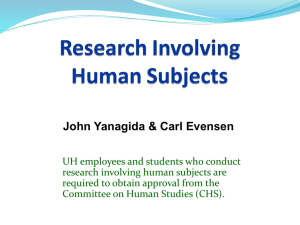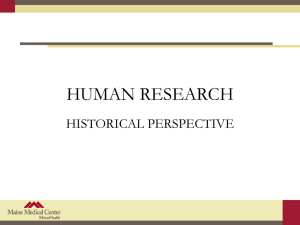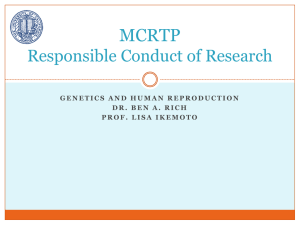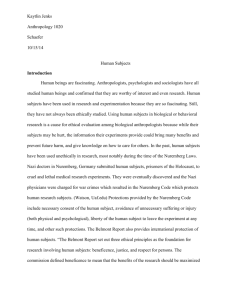1991 Time Line for Human Subject Research and
advertisement
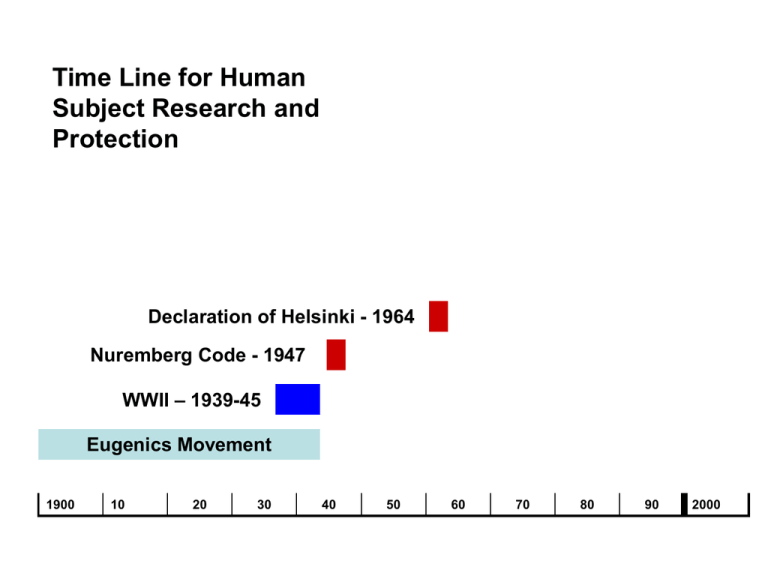
Time Line for Human Subject Research and Protection Declaration of Helsinki - 1964 Nuremberg Code - 1947 WWII – 1939-45 Eugenics Movement 1900 10 20 30 40 50 60 70 80 90 2000 Declaration of Helsinki – 1964 Ethical Principles for Medical Research Involving Human Subjects “… a statement of ethical principles to provide guidance to physicians and other participants in medical research involving human subjects.” “It is the duty of the physician to promote and safeguard the health of the people. The physician’s knowledge and conscience are dedicated to the fulfillment of this duty.” “In medical research on human subjects, considerations related to the well being of the human subject should take precedence over the interests of science and society.” World Medical Association Updated 1975, 1983, 1989, 1996, and 2000 Ben Shahn – Credo - 1966 Time Line for Human Subject Research and Protection Tuskegee Study – 1932-72 Declaration of Helsinki - 1964 Nuremberg Code - 1947 WWII – 1939-45 Eugenics Movement 1900 10 20 30 40 50 60 70 80 90 2000 Time Line for Human Subject Research and Protection Belmont Report - 1979 Tuskegee Study – 1932-72 Declaration of Helsinki - 1964 Nuremberg Code - 1947 WWII – 1939-45 Eugenics Movement 1900 10 20 30 40 50 60 70 80 90 2000 1. National Research Act - Public Law 93-348 – July 12, 1974 Establishes the National Commission 2. Charge to Commission: Identify the basic ethical principles that should underlie the conduct of biomedical and behavioral research involving humans subjects Develop guidelines which should be followed to assure that such research is conducted in accordance with those principles 3. Smithsonian Institution’s Belmont Conference Center – February 1976 Belmont Report – Basic Ethical Principles Respect for Persons • “Respect for persons incorporates at least two ethical convictions; first that individuals should be treated as autonomous agents, and second, that persons with diminished autonomy are entitled to protection.” • “To respect autonomy is to give weight to the autonomous persons’ considered opinions and choices ….” Department of Energy Radiation Counting in Child – 1950s Belmont Report – Basic Ethical Principles Beneficence • “Persons are treated in an ethical manner … by making efforts to secure their well being … In this document, beneficence is understood … as an obligation.” • “Two general rules have been formulated as complementary expressions of beneficent actions in this sense: (1) do not harm and (2) maximize possible benefits and minimize possible harms.” Department of Energy Radiation Counting in Child – 1950s Belmont Report – Basic Ethical Principles Justice • “Who ought to receive the benefits of research and bear its burdens? This is a question of justice in the sense of ‘fairness in distribution’…” • “… the selection of research subjects needs to be scrutinized … to determine whether some classes (e.g., …persons confined to institutions) are being … selected simply because of their easy availability, their compromised position, or their manipulability, rather than for reasons directly related to the problem being studied.” Department of Energy Radiation Counting in Child – 1950s Time Line for Human Subject Research and Protection I.R.B.s Belmont Report - 1979 Tuskegee Study – 1932-72 Declaration of Helsinki - 1964 Nuremberg Code - 1947 WWII – 1939-45 Eugenics Movement 1900 10 20 30 40 50 60 70 80 90 2000 Institutional Review Boards (IRB) • Responsibilities – Review informed consent document – Assess risks and benefits of proposed research – Review subject selection • Constitution – – – – – At least five members Varied backgrounds Scientists Non-scientists Community members Ben Shahn - 1965 Time Line for Human Subject Research and Protection Common Rule - 1991 I.R.B.s Belmont Report - 1979 Tuskegee Study – 1932-72 Declaration of Helsinki - 1964 Nuremberg Code - 1947 WWII – 1939-45 Eugenics Movement 1900 10 20 30 40 50 60 70 80 90 2000 “Common Rule” 1. Subpart A45 CFR 46 2. Agreed to by 16 Federal Agencies 3. Effective August 19, 1991 4. Sets forth as a common rule requirements for the protection of human subjects involved in research conducted by Federal Departments and Agencies Jesse Gelsinger (Age 18) Facts University of Pennsylvania Institute for Human Gene Therapy Ornithine Transcarbamylase (OTC) Deficiency Adenovirus Vector Dies September 17, 1999 Issues Problems not reported to IRB Eligibility questions Conflicts of Interest Ellen Roche (Age 24) Facts Johns Hopkins Medical Institution Healthy Volunteer Study of Airway Reactions Inhales Hexamethonium Dies June 2, 2001 Issues Institutional Responsiveness Inadequate IRB Review Studies from 1950s describing Hexamethonium toxicities not identified Time Line for Human Subject Research and Protection R.S.A. Common Rule - 1991 I.R.B.s Belmont Report - 1979 Tuskegee Study – 1932-72 Declaration of Helsinki - 1964 Nuremberg Code - 1947 WWII – 1939-45 Eugenics Movement 1900 10 20 30 40 50 60 70 80 90 2000 Research Subject Advocates (RSA) • New positions within the GCRCs (2001) • Educate investigators and facilitate the informed consent process • Assist in developing data safety monitoring plans for research protocols • Audit research records to assure compliance with federal regulations Ben Shahn – In Quiet Rooms - 1969 Over the past century, the process of conducting research with human subjects has improved with substantial gains in human health. Yet each day brings new challenges, and we must remain vigilant. Ben Shahn – Birds Fly - 1968

